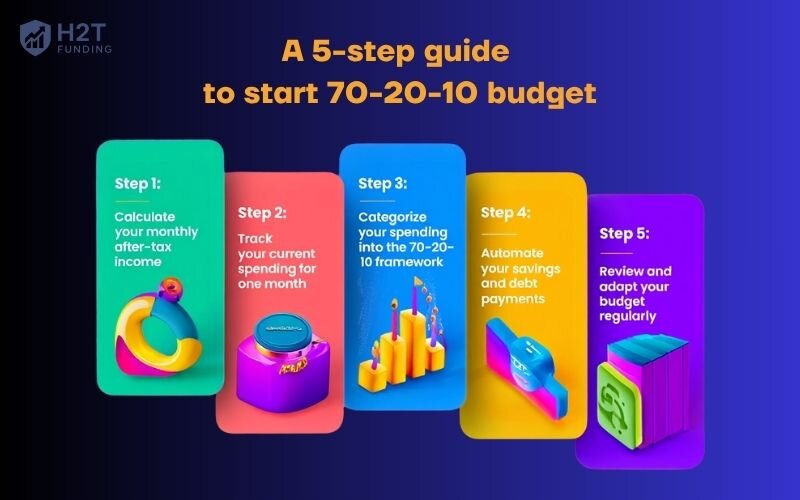Budgeting often sounds overwhelming, tracking every dollar, juggling expenses, and trying to save can feel like a second job. But it doesn’t have to be that complicated.
The 70-20-10 rule is a simple yet powerful budgeting method designed to help you take control of your money without obsessing over every expense. It offers a flexible, beginner-friendly way to allocate your after-tax income into three main categories: spending, saving, and debt or giving.
Whether you’re just starting out or looking for a better system, this guide will break down exactly what is the 70 20 10 rule money is, how it works with real-life examples, and how you can apply it today to feel more confident and in control of your finances.
Key takeaways:
- The 70-20-10 rule offers a simple budgeting framework by dividing your after-tax income into 70% for expenses, 20% for savings/investments, and 10% for debt repayment or giving.
- Tracking and categorizing your spending is essential before applying the rule, ensuring that your budget reflects your real habits and highlights areas for adjustment.
- Compared to other budgeting methods, such as the 50-30-20 rule or zero-based budgeting, the 70-20-10 rule prioritizes ease and less mental load, especially for those feeling overwhelmed by too many categories.
- While not a one-size-fits-all solution, the rule is a practical and empowering starting point to build financial confidence and break the paycheck-to-paycheck cycle.
1. What is the 70 20 10 rule money?
The 70-20-10 rule is a simple way to split your after-tax income into three buckets. Instead of tracking dozens of categories, you just focus on three, making sure every dollar has a job.

Here’s how the breakdown works:
- 70% for daily life: This majority portion goes toward your monthly living costs. It includes both essential needs, like rent, utilities, groceries, and transportation, and personal wants, such as dining out, shopping, streaming services, and hobbies.
- 20% for savings and investments: This slice is for your future. It could be used to grow an emergency fund, save for a down payment, or invest in retirement through accounts like a 401(k) or IRA. Automating this portion helps build financial security over time.
- 10% for debt repayment or giving: The final part is for reducing debts, such as credit cards or student loans, or giving back to causes you care about. This is in addition to minimum debt payments already covered in the 70% expense bucket.
This structure offers balance without rigidity, making it ideal for those new to budgeting.
2. A practical example of the 70-20-10 rule in action
Let’s look at a practical example to see how this works. Meet Alina, who felt stuck in a paycheck-to-paycheck cycle despite earning a decent salary. With a monthly after-tax income of $4,000, she decided to commit to the 70-20-10 money rule to finally get ahead.
- 70% for expenses: $2,800
This covered her rent, groceries, car payment, insurance, and everyday spending like coffee runs and weekend outings. Before adopting the rule, her discretionary spending often ate into savings. With a clear cap, she became more selective and intentional with her non-essential purchases.
- 20% for savings and investments: $800
Alina opened a high-yield savings account and began contributing to a Roth IRA. Within seven months, she had saved over $5,000 and gained the confidence to start investing in ETFs. “It was the first time I felt in control of my financial future,” she said.
- 10% for debt repayment/giving: $400
She used this to aggressively pay down her remaining credit card balance, cutting her interest payments in half within four months. She also set aside a small portion for monthly donations to a literacy nonprofit she supports.
The first couple of months were an adjustment. It meant swapping a few nights out for home-cooked meals and thinking twice before clicking ‘buy now.’ But as she saw the results, the clarity and control the rule provided made those trade-offs feel less like sacrifices and more like empowering choices.
May you need to know: How to stop living paycheck to paycheck in 9 easy steps
3. How to start your 70-20-10 budget: A 5-step guide
Once you’ve understood what is the 70 20 10 rule money, the next step is turning that knowledge into a practical habit. Here’s how to start your 70-20-10 budget.

3.1. Step 1: Calculate your monthly after-tax income
Before applying the 70-20-10 rule, you need a clear picture of your take-home pay, that is, your income after taxes and other automatic deductions like health insurance or retirement contributions (e.g., 401(k)).
For salaried employees, this is the amount you see deposited into your checking account each payday. If you’re self-employed or have a variable income, calculate an average from the last 3 to 6 months. Use your bank statements or accounting tools like QuickBooks or FreshBooks to determine this number accurately.
3.2. Step 2: Track your current spending for one month
Before you can divide your income using the 70-20-10 framework, you need to understand where your money currently goes. Spend one full month tracking every expense, no matter how small, from your morning coffee to monthly subscriptions.
You can use budgeting apps like YNAB (You Need A Budget), or simply a budget spreadsheet or notes app. The goal isn’t to judge yourself; it’s to gather accurate data.
Break your spending into categories like:
- Housing
- Transportation
- Food (groceries + dining out)
- Subscriptions
- Entertainment
- Utilities
- Miscellaneous
At the end of the month, total each category. You may be surprised to find areas where you overspend without realizing it.
3.3. Step 3: Categorize your spending into the 70-20-10 framework
Now that you’ve tracked your spending, it’s time to sort those expenses into the three categories defined by the 70-20-10 rule:
- 70% for expenses: Includes all essentials and personal lifestyle costs, like rent, groceries, transportation, entertainment, and subscriptions.
- 20% for savings and investments: Covers emergency funds, retirement contributions (outside of employer deductions), or brokerage accounts.
- 10% for debt repayment or giving: Extra debt payments beyond minimums or charitable donations.
Use a simple spreadsheet or a budgeting app that supports custom categories. This step will show whether your current habits align with the 70-20-10 rule, or if adjustments are needed.
Almost no one does at first. The goal here isn’t perfection; it’s clarity. If you find out you’re spending 85% on expenses, that’s not a reason to quit. It’s simply your starting point. Now you have a real number to work with, and you can start looking for small areas to adjust.
3.4. Step 4: Automate your savings and debt payments
Automation is the key to making the 70-20-10 rule stick, especially the savings and debt repayment portions. Set up automatic transfers on payday so the money moves before you have a chance to spend it.
Here’s how:
- Schedule 20% of your income to go directly into a high-yield savings account or investment platform (like Roth IRA, index funds, or a brokerage account).
- Direct 10% to credit card payments or loan accounts beyond the minimum, or to a separate account earmarked for charitable giving.
Most banks and fintech apps (like Ally, Capital One 360, or Betterment) allow you to automate this with ease. You’re essentially “paying yourself first”, and that’s one of the smartest financial habits you can build.
3.5. Step 5: Review and adapt your budget regularly
Life isn’t static, and your budget shouldn’t be either. Revisit your 70-20-10 allocations every month or quarter to ensure they still align with your goals and current financial situation.
For example, if you get a raise, pay off a major debt, or take on a new recurring expense, it’s worth adjusting the percentages. You might shift to 60-30-10 to boost savings, or 65-20-15 if you’re aggressively tackling debt.
Use this review time to ask yourself:
- Am I meeting my savings targets?
- Is my spending still within 70%?
- Can I increase my giving or reduce my debt faster?
Read more useful articles:
4. Pros and cons of the 70-20-10 rule
Like any personal finance strategy, the 70-20-10 budgeting rule comes with both strengths and limitations. It’s essential to understand these before deciding whether it aligns with your financial goals and lifestyle. Below is a quick comparison to help you evaluate its practical fit:
| Pros | Cons |
|---|---|
| Easy to understand and implement, no complex categories required. | Allocating 70% to spending can lead to overspending on non-essentials. |
| More flexible than other rules by grouping both “needs” and “wants” together. | It may not work well for individuals with high debt loads; 10% might be too low. |
| Encourages automatic financial habits like saving and debt repayment. | Not ideal for high cost-of-living areas where essential expenses exceed 70%. |
| Less stressful, since you don’t need to track every minor transaction. | Lacks detailed categories, making it harder to identify areas to cut back. |
While the 70/20/10 budget is beginner-friendly and promotes healthy financial behavior, it’s not a one-size-fits-all solution. The key is to treat it as a flexible framework you can adjust to your unique financial situation, rather than a rigid formula.
5. How the 70-20-10 rule compares to other budgets
To make an informed decision, it’s helpful to see how and what is the 70 20 10 rule money stacks up against other popular budgeting methods. The two most common alternatives are the 50-30-20 rule and zero-based budgeting. Each has its own structure, strengths, and ideal use case.
Here’s a side-by-side comparison to help you choose the approach that best matches your financial situation:
| Feature | 70-20-10 Rule | 50-30-20 Rule | Zero-Based Budgeting |
|---|---|---|---|
| Main Concept | 70% expenses, 20% savings, 10% debt/giving. | 50% needs, 30% wants, 20% savings. | Income minus expenses = 0. Every dollar has a job. |
| Simplicity | Very high. Simple categories and structure. | High. Clear separation between needs and wants. | Low. Requires tracking every expense and assigning every dollar. |
| Flexibility | High. Allows flexible spending within the 70%. | Medium. Less room to shift between needs and wants. | Low. Very structured and detailed. |
| Best For… | Beginners who want a non-restrictive, easy-to-follow system. | Those seeking to better control lifestyle expenses. | People with irregular income or who want full control. |
| Main Challenge | Risk of overspending on wants within the 70% category. | Difficult to distinguish clearly between needs and wants. | Time-consuming and mentally demanding for some. |
While the 70-20-10 budgeting rule offers the highest level of simplicity and flexibility, especially for those new to budgeting, other methods may be more appropriate if you’re looking for granular control or need to manage spending with tighter constraints. The best budget is the one you can stick to consistently.
6. FAQs: Your questions about the 70-20-10 rule answered
You don’t need to follow the 70-20-10 rule exactly. Use it as a flexible guide, not a fixed formula. If your income is unstable, start with any ratio that fits, like 80-15-5, and adjust as things improve. The key is to spend less than you earn and save something regularly.
Yes, absolutely. The 70-20-10 rule is just a starting point. You can adjust the percentages to match your goals, like 60-30-10 for more savings or 60-20-20 to pay off debt faster. Flexibility is what makes this method practical.
It helps, but only to a point. If your debt is moderate, 10% may be enough to make steady progress. But for large debts like student loans or medical bills, you may need to adjust the rule, like shifting to 60-20-20, to speed up repayment.
It depends on your goals. The 50/30/20 rule offers clearer separation between needs and wants, while the 70/20/10 rule is simpler and more flexible. Choose the one that fits your lifestyle and feels sustainable.
7. Conclusion
So, in the end, what is the 70 20 10 rule money? It’s not a rigid formula, but a friendly starting point designed to help you take control of your finances without feeling overwhelmed.
To explore more smart strategies and find what truly works for your financial journey, check out our full guide in our Budgeting Strategies section at H2T Funding.





